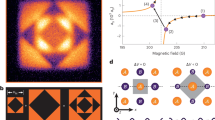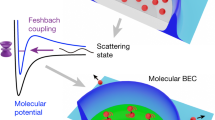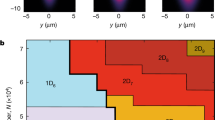Abstract
Many-body quantum systems can exhibit a striking degree of symmetry unparallelled in their classical counterparts. In real materials SU(N) symmetry is an idealization, but this symmetry is pristinely realized in fully controllable ultracold alkaline-earth atomic gases. Here, we study an SU(N)-symmetric Fermi liquid of 87Sr atoms, where N can be tuned to be as large as 10. In the deeply degenerate regime, we show through precise measurements of density fluctuations and expansion dynamics that the large N of spin states under SU(N) symmetry leads to pronounced interaction effects in a system with a nominally negligible interaction parameter. Accounting for these effects, we demonstrate thermometry accurate to 1% of the Fermi energy. We also demonstrate record speed for preparing degenerate Fermi seas enabled by the SU(N)-symmetric interactions, reaching T/TF = 0.22 with 10 nuclear spin states in 0.6 s working with a laser-cooled sample. This, along with the introduction of a new spin polarizing method, enables the operation of a three-dimensional optical lattice clock in the band insulating regime.
This is a preview of subscription content, access via your institution
Access options
Access Nature and 54 other Nature Portfolio journals
Get Nature+, our best-value online-access subscription
$29.99 / 30 days
cancel any time
Subscribe to this journal
Receive 12 print issues and online access
$209.00 per year
only $17.42 per issue
Buy this article
- Purchase on Springer Link
- Instant access to full article PDF
Prices may be subject to local taxes which are calculated during checkout





Similar content being viewed by others
Data availability
The datasets generated and analysed during the current study are available from the corresponding author L.S. on reasonable request.
References
Bloch, I., Dalibard, J. & Zwerger, W. Many-body physics with ultracold gases. Rev. Mod. Phys. 80, 885–964 (2008).
Inguscio, M., Ketterle, W. & Salomon, C. (eds) Making, Probing and Understanding Ultracold Fermi Gases (IOS, 2008).
Cazalilla, M. & Rey, A. M. Ultracold fermi gases with emergent SU(N) symmetry. Rep. Prog. Phys. 77, 124401 (2014).
Horikoshi, M., Nakajima, S., Ueda, M. & Mukaiyama, T. Measurement of universal thermodynamic functions for a unitary Fermi gas. Science 327, 442–445 (2010).
Nascimbéne, S., Navon, N., Jiang, K., Chevy, F. & Salomon, C. Exploring the thermodynamics of a universal Fermi gas. Nature 463, 1057–1060 (2010).
Gorshkov, A. V. et al. Two-orbital SU(N) magnetism with ultracold alkaline-earth atoms. Nat. Phys. 6, 289–295 (2010).
Taie, S., Yamazaki, R., Sugawa, S. & Takahashi, Y. An SU(6) Mott insulator of an atomic Fermi gas realized by large-spin Pomeranchuk cooling. Nat. Phys. 8, 825–830 (2012).
Scazza, F. et al. Observation of two-orbital spin-exchange interactions with ultracold SU(N)-symmetric fermions. Nat. Phys. 10, 779–784 (2014).
Hofrichter, C. et al. Direct probing of the Mott crossover in the SU(N) Fermi-Hubbard model. Phys. Rev. X 6, 021030 (2016).
Goban, A. et al. Emergence of multi-body interactions in a fermionic lattice clock. Nature 563, 369–373 (2018).
Ozawa, H., Taie, S. & Takahashi, Y. Antiferromagnetic spin correlation of SU(N) Fermi gas in an optical lattice. Phys. Rev. Lett. 121, 225303 (2018).
Zhang, X. et al. Spectroscopic observation of SU(N)-symmetric interactions in Sr orbital magnetism. Science 345, 1467–1473 (2014).
Pagano, G. et al. A one-dimensional liquid of fermions with tunable spin. Nat. Phys. 10, 198–201 (2014).
Song, B. et al. Evidence for bosonization in a three-dimensional gas of SU(N) fermions. Preprint at https://arxiv.org/abs/1912.12105 (2020).
He, C. et al. Collective excitations in two-dimensional SU(N) Fermi gases with tunable spin. Phys. Rev. Res. 2, 012028 (2020).
Stellmer, S., Schreck, F. & Killian, T. C. in Annual Review of Cold Atoms and Molecules Ch. 1 (World Scientific, 2014).
Hazzard, K. R. A., Gurarie, V., Hermele, M. & Rey, A. M. High-temperature properties of fermionic alkaline-earth-metal atoms in optical lattices. Phys. Rev. A 85, 041604 (2012).
Bonnes, L., Hazzard, K. R. A., Manmana, S. R., Rey, A. M. & Wessel, S. Adiabatic loading of one-dimensional SU(N) alkaline-earth-atom fermions in optical lattices. Phys. Rev. Lett. 109, 205305 (2012).
Messio, L. & Mila, F. Entropy dependence of correlations in one-dimensional SU(N) antiferromagnets. Phys. Rev. Lett. 109, 205306 (2012).
Yip, S.-K., Huang, J. & Kao, J. Theory of SU(N) fermi liquids. Phys. Rev. A 89, 043610 (2014).
Campbell, S. L. et al. A Fermi-degenerate three-dimensional optical lattice clock. Science 358, 90–94 (2017).
Marti, G. E. et al. Imaging optical frequencies with 100μHz precision and 1.1μm resolution. Phys. Rev. Lett. 120, 103201 (2018).
Oelker, E. et al. Demonstration of 4.8 × 10−17 stability at 1 s for two independent optical clocks. Nat. Photon. 13, 714–719 (2019).
McGrew, W. F. et al. Atomic clock performance enabling geodesy below the centimetre level. Nature 564, 87–90 (2018).
Huntemann, N., Sanner, C., Lipphardt, B., Tamm, C. & Peik, E. Single-ion atomic clock with 3 × 10−18 systematic uncertainty. Phys. Rev. Lett. 116, 063001 (2016).
Sanner, C. et al. Optical clock comparison for Lorentz symmetry testing. Nature 567, 204–208 (2019).
Kolkowitz, S. et al. Gravitational wave detection with optical lattice atomic clocks. Phys. Rev. D 94, 124043 (2016).
Xu, V., Jaffe, M., Panda, C., Clark, L. & Müller, H. Probing gravity by holding atoms for 20 seconds. Science 366, 745–749 (2019).
Schioppo, M. et al. Ultrastable optical clock with two cold-atom ensembles. Nat. Photon. 11, 48–52 (2017).
Hutson, R. B. et al. Engineering quantum states of matter for atomic clocks in shallow optical lattices. Phys. Rev. Lett. 123, 123401 (2019).
Loftus, T., Ido, T., Ludlow, A., Boyd, M. & Ye, J. Narrow line cooling: finite photon recoil dynamics. Phys. Rev. Lett. 93, 073003 (2004).
Stellmer, S., Grimm, R. & Schreck, F. Production of quantum-degenerate strontium gases. Phys. Rev. A 87, 013611 (2013).
Julienne, P. S., Smith, A. M. & Burnett, K. in Advances In Atomic, Molecular, and Optical Physics Vol. 30 (eds Bates, D. & Bederson, B.) 141–198 (Academic, 1992).
Sesko, D. W., Walker, T. G. & Wieman, C. E. Behavior of neutral atoms in a spontaneous force trap. J. Opt. Soc. Am. B 8, 946–958 (1991).
Stellmer, S., Pasquiou, B., Grimm, R. & Schreck, F. Laser cooling to quantum degeneracy. Phys. Rev. Lett. 110, 263003 (2013).
Mukaiyama, T., Katori, H., Ido, T., Li, Y. & Kuwata-Gonokami, M. Recoil-limited laser cooling of 87Sr atoms near the Fermi temperature. Phys. Rev. Lett. 90, 113002 (2003).
Fukuhara, T., Takasu, Y., Kumakura, M. & Takahashi, Y. Degenerate Fermi gases of ytterbium. Phys. Rev. Lett. 98, 030401 (2007).
Dick, G. J. Local Oscillator Induced Instabilities in Trapped Ion Frequency Standards. In Proceedings of the 19th Annual Precise Time and Time Interval Meeting, 133-147 (US Naval Observatory, 1988).
Sleator, T., Pfau, T., Balykin, V., Carnal, O. & Mlynek, J. Experimental demonstration of the optical Stern-Gerlach effect. Phys. Rev. Lett. 68, 1996–1999 (1992).
Taie, S. et al. Realization of a SU(2) × SU(6) system of fermions in a cold atomic gas. Phys. Rev. Lett. 105, 190401 (2010).
Stellmer, S., Grimm, R. & Schreck, F. Detection and manipulation of nuclear spin states in fermionic strontium. Phys. Rev. A 84, 043611 (2011).
Lee, Y.-R. et al. Compressibility of an ultracold Fermi gas with repulsive interactions. Phys. Rev. A 85, 063615 (2012).
Callen, H. & T.A., W. Irreversibility and generalized noise. Phys. Rev. 83, 34–40 (1951).
Sanner, C. et al. Suppression of density fluctuations in a quantum degenerate Fermi gas. Phys. Rev. Lett. 105, 040402 (2010).
Müller, T. et al. Local observation of antibunching in a trapped Fermi gas. Phys. Rev. Lett. 105, 040401 (2010).
Danielewicz, P. Quantum theory of nonequilibrium processes, I. Ann. Phys. 152, 239–304 (1984).
Kadanoff, L. P., Baym, G. & Pines, D. Quantum Statistical Mechanics 1st edn (CRC, 2019).
Pedri, P., Guéry-Odelin, D. & Stringari, S. Dynamics of a classical gas including dissipative and mean-field effects. Phys. Rev. A 68, 043608 (2003).
Giorgini, S., Pitaevskii, L. P. & Stringari, S. Theory of ultracold atomic Fermi gases. Rev. Mod. Phys. 80, 1215–1274 (2008).
Menotti, C., Pedri, P. & Stringari, S. Expansion of an interacting fermi gas. Phys. Rev. Lett. 89, 250402 (2002).
Castin, Y. & Dum, R. Bose-Einstein condensates in time dependent traps. Phys. Rev. Lett. 77, 5315–5319 (1996).
Guéry-Odelin, D. Mean-field effects in a trapped gas. Phys. Rev. A 66, 033613 (2002).
O’Hara, K. M., Hemmer, S. L., Gehm, M. E., Granade, S. R. & Thomas, J. E. Observation of a strongly interacting degenerate Fermi gas of atoms. Science 298, 2179–2182 (2002).
Burt, E. A. et al. Coherence, correlations, and collisions: what one learns about Bose-Einstein condensates from their decay. Phys. Rev. Lett. 79, 337–340 (1997).
Wolf, J. et al. State-to-state chemistry for three-body recombination in an ultracold rubidium gas. Science 358, 921–924 (2017).
Vichi, L. Collisional Damping of the Collective Oscillations of a Trapped Fermi Gas. J. Low Temp. Phys. 121, 177–197 (2000).
Jackson, B., Pedri, P. & Stringari, S. Collisions and expansion of an ultracold dilute Fermi gas. Europhys. Lett. 67, 524–530 (2004).
Lee, T. D. & Yang, C. N. Many-body problem in quantum statistical mechanics. I. General formulation. Phys. Rev. 113, 1165–1177 (1959).
Lee, T. D. & Yang, C. N. Many-body problem in quantum statistical mechanics. II. Virial expansion for hard-sphere gas. Phys. Rev. 116, 25–31 (1959).
Lee, T. D. & Yang, C. N. Many-body problem in quantum statistical mechanics. III. Zero-temperature limit for dilute hard spheres. Phys. Rev. 117, 12–21 (1960).
Pathria, R. K. & Kawatra, M. P. Quantum statistical mechanics of a many-body system with square-well interaction. Progr. Theor. Phys. 27, 638–652 (1962).
Acknowledgements
We thank T. Bothwell, C. Kennedy, E. Oelker and J. Robinson for discussions and technical contributions. We also thank J. Thompson and C. Kennedy for reading the manuscript. This work is supported by NIST, DARPA, and AFOSR grant nos. FA9550-19-1-0275 and FA9550-18-1-0319, and NSF grant no. PHYS-1734006. C.S. thanks the Humboldt Foundation for support.
Author information
Authors and Affiliations
Contributions
L.S., C.S., R.B.H., A.G., L.Y., W.R.M. and J.Y. contributed to the experimental measurements. T.B. and A.M.R. developed the theoretical model. All authors discussed the results, contributed to the data analysis and worked together on the manuscript.
Corresponding authors
Ethics declarations
Competing interests
The authors declare no competing interests.
Additional information
Peer review information Nature Physics thanks Stefano Giorgini, Florian Schreck and the other, anonymous, reviewer(s) for their contribution to the peer review of this work.
Publisher’s note Springer Nature remains neutral with regard to jurisdictional claims in published maps and institutional affiliations.
Rights and permissions
About this article
Cite this article
Sonderhouse, L., Sanner, C., Hutson, R.B. et al. Thermodynamics of a deeply degenerate SU(N)-symmetric Fermi gas. Nat. Phys. 16, 1216–1221 (2020). https://doi.org/10.1038/s41567-020-0986-6
Received:
Accepted:
Published:
Issue Date:
DOI: https://doi.org/10.1038/s41567-020-0986-6
This article is cited by
-
Probe for bound states of SU(3) fermions and colour deconfinement
Communications Physics (2023)
-
Realization of highly isolated stable few-spin systems based on alkaline-earth fermions
Frontiers of Physics (2023)
-
Laser cooling for quantum gases
Nature Physics (2021)
-
Heuristic machinery for thermodynamic studies of SU(N) fermions with neural networks
Nature Communications (2021)



